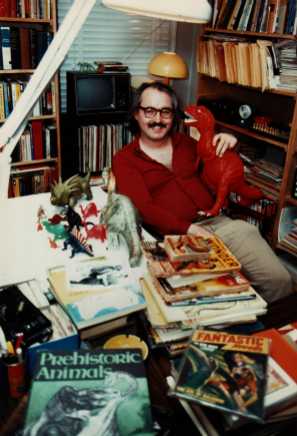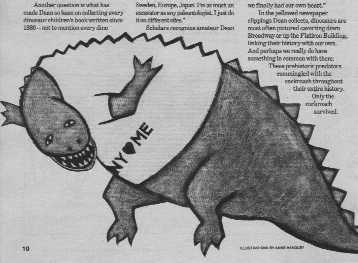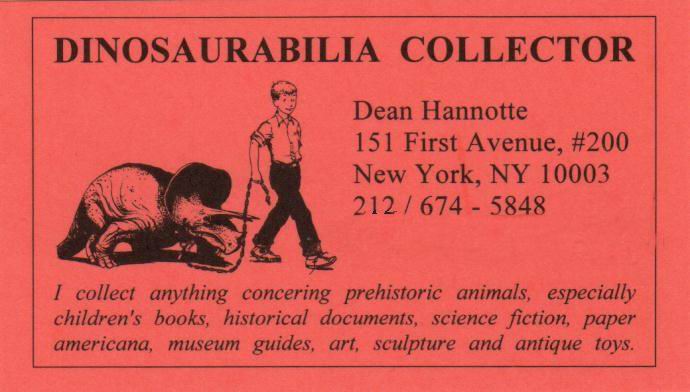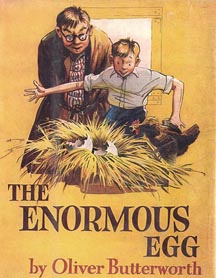The Metropolitan Museum of Mesozoic Memorabilia
I have been fascinated all my life with dinosaurs and their depiction in drawings, paintings, fiction and non-fiction. I have a calling card I hand out that says "I collect anything concerning prehistoric animals, especially children's books, historical documents, science fiction, paper american, museum guides, art, sculpture, and antique toys."

Illustration from "The Enormous Egg" by Oliver Butterworth, my favorite book as a child |
This collection has grown so large that my friends now call it the Metropolitan Museum of Mesozoic Memorabilia. According to Don Glut, who wrote The Dinosaur Scrapbook, it is the largest print collection of its kind. (He still has the largest private collection of three-dimensional dinosaur stuff — fossils and models and such.)
My public appearances began in the spring of 1980 when I gave an exhibition called DINOSAURABILIA at the home office of the Metropolitan Life Insurance Company, which showcased my collection of memorabilia about dinosaurs and other prehistoric animals. The pamphlet I distributed said:
|
"In one way or other I have been building this collection all my life (I'm 34). It includes:
"It all started when I was five. My father used to take the family to the American Museum of Natural History, where I'd gape at the gigantic dinosaur skeletons and run to the bookshop for souvenirs. Then my father took me to my first movie, The Beast from 20,000 Fathoms. I was so excited that when the dinosaur finally appeared on the screen I threw up. I soon found the word 'paleontology' in the dictionary and started using it to amaze my friends. Ends of the Earth, by Roy Chapman Andrews, told me just how to find dinosaur eggs in the Gobi desert. By this time I had a dinosaur fever of 105 degrees. "Although I have not chosen paleontology as a profession, my interest in man's fascination with prehistoric animals has never waned. I correspond with 300 rare book dealers, and advertise in antiques and collectibles magazines. I gather up duplicates to trade with fellow collectors. On a slow day I'll even write dinosaur limmericks, or coin words like paleophily and sauropodiatry. I guess you could say I'm a . . . DINOSAURABILIAC!" |
Over the years, a few other people have written up this collection too. Here are some of the articles that have appeared:
America's Top Dinosaur Hunter
by Tom Hanley
Dinosaur Collectibles
by Dean Hannotte
|
Collecting Hints: Don't look at the National Gallery of Art, Sotheby's or any branch of Bloomingdale's. Do scout the corner candy store, the five and dime, Sunday comics, children's artwork and poetry, and Macy's toy department on Christmas eve. For dinoamericana of past decades raid flea markets, garage sales, church bazaars and book and antique dealers. With any luck you will soon have more dinosaur books, cards, clothes, coins, comics, figurines, films, glassware, jewelry, models, novelties, postcards, posters, promos, pulps, puzzles, slides, souvenirs, stamps and toys than you will know what to do with. History: Dinosaur collectibles, known as dinosaurabilia, are found in every nook and cranny of modern American culture. We are the only civilized nation to have erected a national monument to the dinosaur, though we did our best to hide it away in Utah.
The dinosaur holds roughly the same place in the American mythos as does the dragon in Europe; but we seem to have taken this love affair to indecent extremes. Long before they can remember the names of five U.S. presidents, children of both genders routinely rattle off vital statistics of whole families of prehistoric reptiles, astounding their elders with Latin scientific names delivered trippingly on the tongue. The world's first dinosaur skeleton was described in 1858 by Dr. Joseph Leidy, curator of the Academy of Natural Sciences of Philadelphia. In the late 19th century, Edward Drinker Cope and Othniel Charles Marsh waged their celebrated war over the fossil fields of the West, making the dinosaur a household word. Fanciful exaggerated drawings of antediluvian monsters began usurping the space usually reserved for redskins on the warpath in all the Sunday supplements. Natural history museums began mounting complete skeletons in awe-inspiring poses, providing dramatic and concrete evidence for the idea of biological evolution. In no time at all the hucksters and capitalizers moved in, charging admission to fraudulent finds and selling worthless fragments of cattle bones for outrageous prices. Still, many interesting and valuable pieces of Americana survive from these hectic years in the form of museum postcards, newspaper clippings and, for the purist, airy scientific publications. In the 20th century, Hollywood rushed in where devils feared not to tread. Many allusions to prehistoric life can be found in the short subjects of the period, including those of D. W. Griffith. But it was not until 1925 that the first authentic classic of the paleocinema arrived in the form of Willis O'Brien's "The Lost World," followed in 1932 by O'Brien's "King Kong" with its lovingly crafted monsters based exclusively on the superb scientific illustrations of Charles R. Knight. The American public no longer had any doubts about its unofficial national mascot. O'Brien and his successor, Ray Harryhausen, have done more to fan the flames of international paleomania, and are better known, than all the dedicated paleontologists who made the original finds. Dinosaurs and their prehistoric friends had a foothold they would not begin to relinquish until spaceships began landing men on the moon. The term dinosaur, incidentally, refers only to land-dwelling reptiles. Anyone who collects dinosaur material also will be interested in flying reptiles, sea dwelling reptiles and prehistoric mammals, such as the mastodon the sabre-tooth tiger. For an authoritative account of the origin and evolution of modern dinosaurabilia, refer to The Dinosaur Scrapbook. References: Donald F. Glut, The Dinosaur Scrapbook, Citadel Press, 1980; Sylvia Massey Czerkas and Donald F. Glut, Dinosaurs, Mammoths and Cavemen: The Art of Charles R. Knight, Dutton, 1982; William Stout, illustrator, The Dinosaurs, Bantam, 1981. Also see books by L. B. Halstead, Britain's currently reigning king of the tyrant lizards. Periodical: News Bulletin, Society of Vertebrate Paleontology, Florida State Museum, University of Florida, Gainesville, FL 32611. Collectors Clubs: The Dinosaur Club, P.O. Box 164, Kingston Upon Thames, Surrey KT1 3SQ, England. Publishes The Dinosaur Times, quarterly; Dinosaur Nature Association, c/o Executive Secretary, Jensen, Utah 84035. Organized in 1956 to assist the National Park Service with educational activities at Dinosaur National Monument. Annual membership: $1.00, no benefits except membership card with stegosaurus printed on it; a group of German philatelists who specialize in paleontology, geology, mineralogy and speleology can be reached care of Johan Chr. van Soeren, Steinknock 3, 8520 Erlangen-Sieglitzhof, West Germany. Museums: Academy of Natural Sciences, Philadelphia, PA; American Museum of Natural History, New York, NY; Carnegie Museum of Natural History, Pittsburgh, PA; U. S. National Museum of Natural History, Smithsonian Institution, Washington, D.C. The Academy of Natural Sciences, under the direction of Hollister Knowlton, is assembling a new hall on dinosaur paleontology with special emphasis on the dinosaur's impact on popular culture as seen through the newspapers, science fiction, children's toys and other types of collectibles. Park: Dinosaur National Monument, Jensen, Utah. -- reprinted from Warman's Americana & Collectibles, 1984. |
Here A Gronk, There A Gronk, Everywhere A Gronk Gronk
by Lenore Skenazy
|
Dinosaur scholars visiting New York journey first to the American Museum of Natural History, then speed down to East Ninth Street. There, in a cramped and cat fur-filled apartment, a genial man named Dean Hannotte introduces them to four friendly felines and one of the world's largest collections of dinosaurabilia — everything dinosauresque, except for (this is, after all, his apartment) skeletons.
Dinos flowered in the land from about 200 million years ago to about 70 million years ago. In graspable city terms, that's a 130 million-year lease. By comparison, man's been renting here for a mere million and a half. "We're like a little experiment," chuckles Hannotte, in real life a computer programmer. "It's not clear if we're going to do well on this planet, but they were definitely survivors. The question is not why they died. It's 'What made them so successful?'" Another question is: What has made Dean so keen on collecting every dinosaur children's book written since 1880 — not to mention every dino figurine, puzzle, comic book, trading card, rubber stamp, oil painting, and dish towel? (The latter is hanging damp in the kitchen; this is not a man who keeps his collection behind glass.) The answer, as with so many Mysteries of Life, lies in the Bronx. "My dad took me to see 'The Beast from 20,000 Fathoms' when I was about 6," recalls Parckchester-born Dean. "When the dinosaur came on, I was excited in a way I'd never been. I immediately ran to the bathroom and threw up." That's amore. Later on, the American Museum of Natural History played its role, too. The skeletons there also inspired several of his friends; one, Richie Mirissis of Staten Island, now boasts the world's largest collection of Godzillabilia. "We created our own fields," says Dean. "I dig in bookstores and thrift shops for my artifacts. I'm in touch with 500 collectors all over the world — Sweden, Europe, Japan. I'm as much an excavator as any paleontologist. I just do it on different sites." Scholars recognize amateur Dean as a bona fide expert: The Academy of Natural Sciences in Philadelphia invited him to consult on its "Discovering Dinosaurs" exhibit, slides from his collection were screened recently at our own American Museum of Natural History, and he's lectured at the prestigious (well, fun) Dinomania Festival at Dinosaur State Park in Connecticut. The search for real dinosaur relics began about 1870 in America, with fierce rivals Othniel Charles Marsh and Edward Drinker Cope "competing out west to find bones," reports Dean. "They were so competitive they'd blow up each other's finds and hire Indians to attack." At that time, "dino-mania became what dragon-mania is in Europe," Dean Explains. Until then, America didn't have a monster to call its own. "All the stories about dragons concerned European history. When dinosaurs were found in this country, we finally had our own beast." In the yellowed newspaper clippings Dean collects, dinosaurs are most often pictured cavorting down Broadway or up the Flatiron Building, linking their history with our own. And perhaps we really do have something in common with them: These prehistoric predators commingled with the cockroach throughout their entire history. Only the cockroach survived.
--
reprinted from her March 19, 1989 "Only in New York" column |
Dinosaurabilia: Saurians in Popular Culture
by Richard Milner
|
Two-hundred years ago no one had even heard of a dinosaur. Today children play with dinosaur toys, visit Dinosaur National Monument, even eat dinosaur-shaped breakfast cereals. During the 1980s a veritable explosion of dinosaur merchandising swept America, replacing Teddy bears and Disney characters as the most ubiquitous image in popular culture. The term "Dinosaurabilia" was coined in 1980 by Dean Hannotte, a Manhattan computer expert whose passion is collecting anything connected with dinosaurs. Hannotte has assembled thousands of rare items, ranging from original paintings by Charles R. Knight (the father of dinosaur art) to early paleontological books, cereal premiums, toys, night lights, stereopticon slides, inflatables, jewelry, cards, models kits, neckties, pulp magazines, soaps and comic books.
Among the quality collectibles are the line of Sinclair Oil Company premiums, glassware and stamp books issued at gas stations in the 1930s and 1950s with the company's "Dino" logo. Rare illustrated books by artists such as Knight and the Czech painter Zdenek Burian are also coveted, as are promotional materials from early dinosaur movies, including the original King Kong (1933), with its classic dinosaur scenes based on Knight's illustrations. The most authoritative account of the origin and evolution of dinosaurabilia is The Dinosaur Scrapbook (1980), written by Donald F. Glut, one of the world's champion collectors of Dinosaurabilia. -- reprinted from The Encyclopedia of Evolution, 1990. |
Living With Dinosaurs:
Inside the mind of a man who makes fantasy seem real
by Miriam Bensimhon
|
Dinosaurs are America's national monsters, as much a part of our historical mythology as dragons are to Europe's. Like so much that is American, this mythology is of fairly recent vintage, having its origins in that place where science meets pop culture. (Remember Godzilla? Or Sinclair Oil's Dino?) But relative newness doesn't limit our fascination with things dinosaurian. Paleontologists do their part — discovering, on average, a new dinosaur every seven weeks — and the media do theirs. Who can blame them? Peter Dodson, coeditor of The Dinosauria, claims "Slap a dinosaur on anything and it'll sell." And Sheryl Leach, who created PBS's Barney, admits that her dinosaur was originally a teddy bear. Then she took her son to a dinosaur exhibit. "I thought, 'Why not capiitalize on the appeal of dinosaurs?'"
But what is the appeal? "Dinosaurs remind us of our smallness," claims Michael Crichton, author of Jurassic Park, a novel in which dinosaurs are brought back to life. "It used to be that people saw the stars. Now people live in cities and are not reminded daily of their place in the universe. Dinosaurs give us that perspective. And anxiety about the environment translates into renewed interest." New York collector Dean Hannotte, who calls his assortment of stuff the Metropolitan Museum of Mesozoic Memorabilia, agrees: "You can't help but be struck in your soul by the gigantism of these animals." Perhaps that's why kids love dinosaurs — because they're big (and scary) like grown-ups. But Smithsonian paleontologist Michael Brett-Surman thinks it has to do with "Big, like power, not parents." San Francisco child psychologist Stevanne Auerbach seconds that. "Kinds can control and master scaled-down dinosaur toys, even though they know dinosaurs were much bigger." But Don Lessem, a writer who founded the Dinosaur Society, which raises money for dinosaur research and public education, says, "I prefer the simple explanation: Dinosaurs are neat." -- reprinted from the October 1992 issue of "Life Magazine". |


!["Warman's Americana and Collectibles" [1984]
(click to enlarge)](Warman-050.jpg)




